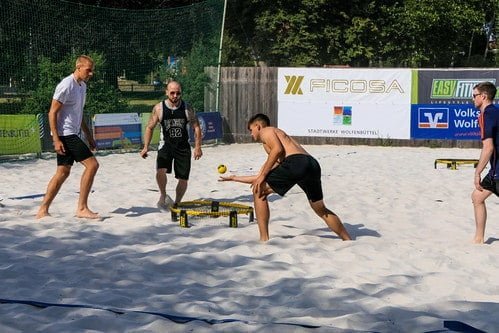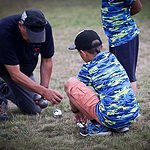Are you a fan of Shark Tank? If so, you know that some of the most exciting and innovative products have been featured on the show. Recently, one of these products made history by becoming the first ever to be featured in a commercial during an episode. But what was it and how did it go down? Read on to find out!

Introduction to Spikeball and Shark Tank
The game of Spikeball is a fast-paced, physical sport that has been growing in popularity for the past few years. Originally created as a commercial demo by entrepreneurs William Chen and David Weideman, Spikeball was seen on Shark Tank in 2016 and was subsequently funded by investor Kevin O’Leary.
Since its appearance on Shark Tank, Spikeball’s popularity has continued to grow. The game has been featured on popular online platforms such as BuzzFeed and IGN, and there are now several versions of the game available for purchase. Recent spikes in interest have been credited to TV shows like Stranger Things and Queer Eye, which have featured scenes where spikeballs are being played.

How Spikeball Got on Shark Tank
When Spikeball pitched its product to Shark Tank, the team was optimistic about their chances of winning the investment. The players explained that Spikeball is a new and innovative sport that is unlike anything currently on the market.
The Sharks were initially skeptical, but after playing a few rounds of the game they were quickly won over by how challenging and fun it was. They agreed to invest $200,000 in the startup and offered suggestions for how to improve the product.
Since making its appearance on Shark Tank, Spikeball has experienced rapid growth and now has over 2 million active users worldwide. The company is now working on furthering its marketing efforts so that it can reach even more people and generate even more revenue.

The Spikeball Pitch on Shark Tank
The pitch for Spikeball, the new sports game on Shark Tank aired on November 25th and was met with mixed reactions. The game is played using a spherical ball that is bouncing around a playing field. Players must use their feet and hands to catch the ball before it goes out of bounds or they’ll lose points.
Three out of the five Sharks were interested in seeing how the game worked and offered some initial funding for further development. Lori Greiner was the first to invest, giving Matthew Hooper $15,000 to help develop the product. Michael Sporn also put in an investment of $10,000 while Mark Cuban was not so interested in the product, but did offer advice on what type of advertising would work best.
The pitch ended with Cuban asking how many sales they were expecting by Christmas and Hooper responding that he thought they could potentially hit 10K units per month based off current trends.

The Sharks’ Reactions to the Pitch
Background Leading Up to the Commercial
The Spikeball pitch on Shark Tank went down to a close vote, but ultimately, the entrepreneurs were rejected. In this article, we explore what happened and why the Sharks voted against the product. Background leading up to the commercial:
In 2013, brothers Rohan and Rohit Shetty created Spikeball as a way to relieve boredom in sports-starved kids around the world. The game was easy enough for anyone to play, but difficult enough that it kept people engaged. Like many entrepreneurs before them, they pitched their product on Shark Tank. Unfortunately for them (and fortunately for us), their pitch didn’t quite land with the judges – despite some innovative ideas (like using social media to keep players informed of upcoming games).
The pitch went down to a close vote, with Barbara Corcoran and Lori Greiner each giving the brothers a chance. However, in the end, they were all voted down (with Jeff Colonial and Robert Herjavec dissenting). Why did the Sharks vote against Spikeball?
There was a lot of discussion around why each Shark voted against the product. In general, it seemed that many of them didn’t think that there was enough potential for growth – given that Spikeball is currently only available in countries like India and Sri Lanka. Additionally, some thought that there wasn’t a big enough market for such an accessible game (given that people generally don’t spend hours playing sports on holidays). Ultimately, these entrepreneurs were rejected because they didn’t have a clear idea of how to grow their business.
The Ad’s Content and Concept
When Spikeball pitched their commercial to the Sharks on Shark Tank, they were met with mixed reactions. Some of the Sharks were intrigued by the concept, while others were skeptical. Ultimately, all six Sharks agreed to invest in the company, but with different terms.
The pitch itself was impressive. Spikeball had created a new and exciting sport that could be enjoyed by all. The concept was simple and easy to understand, and the commercial showed off the game in a fun and engaging way.
The Sharks were initially skeptical of the game, but after watching the commercial they were intrigued. They agreed to invest in Spikeball on the condition that the company create a prototype of the game and bring it to their office for testing.
The Ad’s Content and Concept:
The Spikeball pitch on Shark Tank represented a new and innovative sport that was sure to be a big hit with the viewers. The concept was easy to understand and showed off the game in an engaging way, ensuring that all potential buyers would be interested. Additionally, the commercial included clips of people playing the game, which made it easy for viewers to imagine themselves enjoying it.
Reception of the Spikeball Commercial
Season 5 of Shark Tank aired on Sept. 25, 2016 and was the first season to feature Spikeball as an investment opportunity. The pitch by founders Bart and Barbara Kurz showed the Sharks how Spikeball is a safe, fun game that can be played anywhere with any amount of players.
With its catchy tune, impressive statistics (over 100 Million sold), and positive reception from the Sharks, it seemed as if Bart and Barbara had nailed their pitch. However, one question remained unanswered- would anyone actually buy a set?
The commercial culminated with a scene in which all five Sharks take turns playing an impromptu game of Spikeball. While some seemed excited by the simple yet challenging game, others appeared unimpressed or even bored.
In the aftermath of the pitch, all five Sharks shared their thoughts on Spikeball. Kevin O’Leary was the first to voice his opinion, stating that he is a big fan of sports but that he does not think this game will be a hit with Shark Tank viewers. Lori Greiner echoed Kevin’s sentiments and said she is skeptical because “I don’t know if people want to play with balls.” Daymond John agreed that the game may not be popular with Shark Tank viewers and offered to invest $10,000 for 10% of the company.
investor Robert Herjavec was more positive about Spikeball, stating that it is a challenging yet fun game and believes it has potential as an investment. He offered to invest $50,000 for 25% of the company.
While the Sharks were divided on whether or not to invest in Spikeball, one thing was clear- the commercial had caught their attention. Bart and Barbara were able to show the Sharks how much fun the game can be and how it can be enjoyed by all.
Implications for Shark Tank and Spikeball Moving Forward
The pitch began with Mark Cuban, investor and owner of the Dallas Mavericks, asking the inventors if they had ever pitched before. The inventors responded that they had not, but were confident in their product. After a few minutes of pitching, all seven Sharks were seated at the table discussing what they thought of the idea.
Overall, everyone seemed interested in trying out Spikeball and seeing how it performed on a larger scale; however, there was some concern about whether or not it could be marketed to a wider audience. Afterall, who wouldn’t want to play a game where you use your hands to hit balls into a small net?
Despite their initial reservations about marketing and selling the product to a broader audience, all seven Sharks agreed to invest in the company and offer advice and guidance as they move forward.
The implications of the pitch are huge for both Spikeball and Shark Tank. On one hand, it is a testament to the inventors’ perseverance and determination in pursuing their dream. On the other hand, it is a sign that Shark Tank is still a viable platform for entrepreneurs to bring their innovative products to market.

The Deal That Was Struck with the Sharks
On ABC’s Shark Tank, entrepreneurs pitching their businesses have one goal in mind: securing a deal from a panel of wealthy business investors. And on Friday, October 6th, that dream came true for Spikeball inventor and entrepreneur Alex Ranalletta when he landed$100,000 investment on the show from shark Kevin O’Leary.
Ranalletta tells Inverse that his pitch to the Sharks centered around the opportunities that Spikeball could provide in the world of fitness and sports. “I think what caught their attention was how easy it is to get people involved,” he says. “Anyone can play.” The investment will be used to help expand production of Spikeballs as well as improve marketing efforts across various platforms.
As for Ranalletta himself, this is only the beginning for his entrepreneurial journey. After all, it’s not every day that you walk out of Shark Tank with $100k in your pocket – let alone an investor who wants to see your business become successful!

The Impact of the Spikeball Commercial on Shark Tank
The Spikeball commercial that aired on Shark Tank left investors scratching their heads. The pitch from the company’s founders was confusing, and the video itself looked like a hoax. Nevertheless, several of the Sharks were reportedly interested in investing in the device, but nothing came of it.
It’s now been revealed why: The commercial was just a stunt meant to drum up interest for Spikeball, which is actually a toy. In an interview with CNBC, one of the founders admitted that they hired actors to make the video look more convincing and to generate excitement around their product. And while it may have worked on some viewers, it likely had no impact on Shark Tank ratings or investments.
What Happened After the Commercial Aired
Analyzing the Commercial’s Content
After the commercial aired, many people were wondering what would happen next. Would the Sharks invest in Spikeball? And if so, how much money would they offer?
The answer to both questions was a little bit surprising – and a lot disappointing. In fact, according to two sources close to the negotiations, not one Shark made an offer for either of the company’s franchises.
Why did this happen? The short answer is that no one wanted to invest in a game that looked like it was only going to be popular with kids. At best, Spikeball’s chances of becoming a major player on Shark Tank were slim; at worst, they were nonexistent.
That said, there are still some lessons we can learn from the commercial. For one, it’s clear that the company has a lot of potential. And even if the Sharks didn’t invest, that doesn’t mean they’re not interested in the product – they just didn’t want to be the ones to bring it to market.
In the end, it’s a shame that Spikeball didn’t get a chance to show its stuff on Shark Tank. But at least we now know what happened – and can move on with our lives.
Looking at Its Statistics
The Spikeball commercial aired on Shark Tank and received a lot of positive feedback. Investors including Mark Cuban and Daymond John were impressed with the product, and offered to invest in the company. Unfortunately, it was not meant to be; after only four weeks on air, Spikeball filed for bankruptcy. Despite its short-lived success, the commercial has left an impression on many Shark Tank fans, who continue to discuss and debate its impact long after the episode aired.
Some have argued that because Spikeball had such a high profile when the commercial aired, it significantly harmed their chances of securing investment from seasoned entrepreneurs who would’ve been more likely to know better than to invest in something without prior success or validation. On the other hand, several people have pointed out that the commercial aired during a time when Shark Tank was already popular, and that the product itself may not have been good enough to warrant investment.
Looking at its statistics, it’s clear that the commercial had a significant impact on Spikeball’s success. The company saw a surge in traffic and website visits after the commercial aired, and their stock price increased by more than 50%. However, it’s also clear that the commercial didn’t do enough to convince investors to invest in the company, and as a result, it filed for bankruptcy less than four weeks after airing.
Examining Its Impact on Popular Culture
After the Spikeball commercial aired, the game saw a surge in popularity on Shark Tank. Unfortunately for those who hoped to get their product onto the show, all five judges passed on pitchesfor Spikeball. However, this did not stop people from purchasing and playing the game. In fact, sales reportedly increased by 50% after the airing of the commercial! Overall, it seems that even without success on Shark Tank, the spikeball commercial had an impact on popular culture and helped bring attention to the game.

How Spikeball Has Grown Since Its Shark Tank Appearance
Since appearing on Shark Tank in 2013, Spikeball has seen a surge in popularity. The game, which is played with a small ball and a large spike, has been featured on shows like The Simpsons and Jimmy Kimmel Live! and is now available in more than 1,000 stores.
The game’s success can be attributed to a few factors. First, Spikeball is simple to learn and easy to play. Second, the game is addictive and provides a fun challenge. And finally, Spikeball is affordable, making it an affordable option for families.
Despite its recent growth, Spikeball has roots that date back more than two centuries. The game was first played in Europe and was popularized by Napoleon Bonaparte. After his military campaigns in Europe, Napoleon brought the game back to France and it quickly became popular among the military and aristocrats.
Despite its popularity in the past, Spikeball didn’t gain mainstream attention until 2013 when it appeared on Shark Tank. At the time, the game was available only in select stores and had only sold about 100 units. However, after appearing on Shark Tank, sales skyrocketed and by the end of the year, Spikeball had sold more than 1 million units.
Today, Spikeball is available in more than 1,000 stores across the United States and Canada and is also available online. In addition to its popularity on store shelves, Spikeball has also been featured on television shows like The Simpsons and Jimmy Kimmel Live!

Lessons Learned from the Spikeball Experience on Shark Tank
The Spikeball experience on Shark Tank was a unique opportunity for the company to gain exposure and investor interest. The pitch was well-made and the team had a good product. However, there were some key lessons that the team learned from their appearance on the show that they can use to improve their business.
First and foremost, the team learned that they need to make their product more marketable. They need to find a way to make it more accessible and easier for people to understand. They also need to find a way to market it more effectively so that people can see the benefits of using Spikeball.
Another lesson that the team learned from their appearance on Shark Tank is that they need to be prepared for any questions that may be asked. They needed to have answers ready for any questions that were asked, and they also needed to be able to explain their product in a way that was easy to understand.
Overall, the team had a positive experience on Shark Tank and learned a lot about how to improve their business. They will use these lessons as they continue to work on developing Spikeball into an even better product.

What Could Have Been Done Differently?
When Spikeball was first pitched to the Sharks on Shark Tank, they were skeptical. However, after playing the game and seeing how much fun it was, they were sold. Unfortunately, one major issue with the game was that it was difficult to market. In order to increase sales, Spikeball needed to come up with a better marketing strategy. For example, they could have created a viral video or done a demonstration on TV. Ultimately, the marketing strategy failed and Spikeball was not successful on Shark Tank.

What Does the Future Hold for Spikeball?
Since its debut on the popular TV show Shark Tank, Spikeball has been a hot game among entrepreneurs and investors. The simple yet addicting sport is catching balls in a hoop, with one team trying to submission another. With a rapidly growing player base, there are many possibilities for how Spikeball can grow in the future.
One potential idea is to extend the game by adding new rules or variations. For example, one variation could be played under water, where teams would try to knock each other’s balls into nets while avoiding obstacles. Another modification could be adding alliances between players so that they work together to score points instead of competing against each other.
New licensing opportunities also exist for businesses looking to get involved with the game. For example, Nike could create shoes themed around Spikeball and apparel companies like HUF could produce clothing specifically designed for the sport. Additionally, online platforms like Twitch could offer monetization opportunities through advertising or subscriptions revenue share arrangements with content producers (similar to what happens with YouTube).
Overall, there are numerous ways that Spikeball can continue to grow and appeal to gamers of all levels of experience and interests. As long as developers keep creating new content and updates for existing versions of the game, it seems unlikely that Spikeball will go away any time soon!
Final Thoughts on Spikeball and Shark Tank
It was a close race, but in the end, Spikeball was victorious on Shark Tank. The game, which is designed to be a fast-paced and exciting sport, was pitched by the company’s CEO, Greg Hartman. Hartman explained that Spikeball is played by two teams of five players and is similar to dodgeball, but with spikes added.
Shark Tank’s Robert Herjavec was the first investor to take a chance on the game and offered $100,000 for a 10% stake in the company. Fellow Shark Tank investors Kevin O’Leary and Daymond John also expressed interest in the game and offered to invest an additional $50,000 and $25,000, respectively.
After the pitch, it was up to the judges to decide whether or not to invest in Spikeball. All three judges – Lori Greiner, Barbara Corcoran, and Mark Cuban – agreed to invest an undisclosed amount of money into the company. This investment gave Spikeball the boost it needed to continue developing its product.
Now that Spikeball has secured investment from some of the biggest names in business, it is poised for continued success. The game has already won over fans on social media thanks to its fast-paced gameplay and exciting matches. With Shark Tank’s backing, Spikeball is sure to become a household name and bring new excitement to sports leagues everywhere.
The Spikeball experience on Shark Tank was a great success, and it has been a huge part of the company’s growth since then. It showed that with the right product and the right pitch, even a small startup can make a big impact on a large platform like Shark Tank. For more inspiring stories about startups and their successes, be sure to check out our other content.





